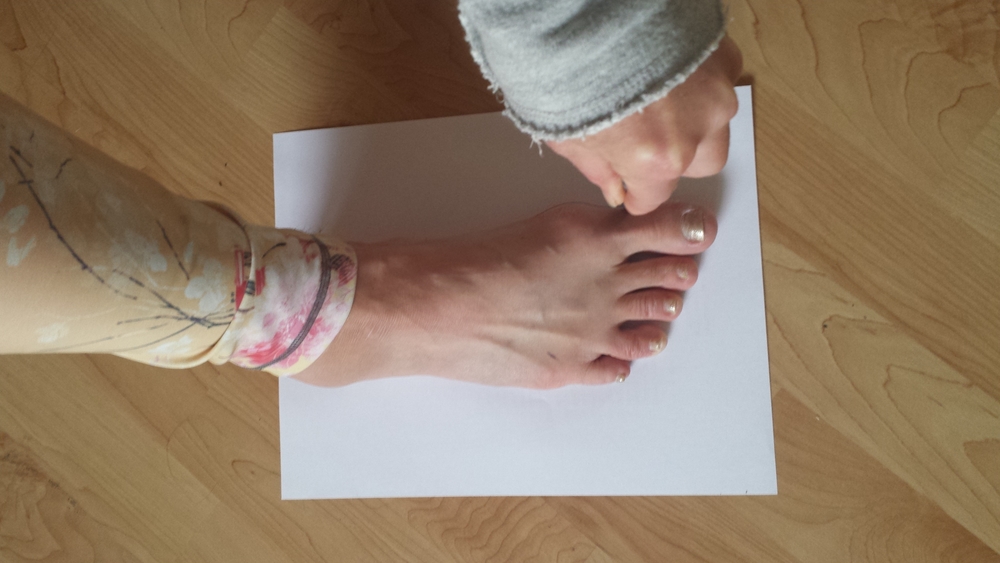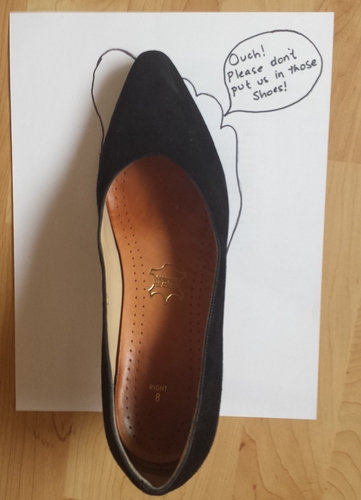If you’ve been to one of my workshops or classes you probably know that I pay a lot of attention to feet. They are the foundation that supports our entire body, our entire posture and if something is not functioning well in the feet it can have a ripple effect on e.v.e.r.y.t.h.i.n.g. In the body, that is.
I often compare this to your house. If there is a cracking or unstable foundation that results in a leaky roof you can patch the roof, only to probably have to patch it again in the near future, or you can deal with the foundation problem first (well maybe cover the hole in the roof while you’re fixing the foundation problem) to get to the root of the matter. If you’ve got something going on with your upper body mechanics (hyperkyphosis, forward head, chronic tension, headaches, etc.) you can focus on exercises to strengthen and mobilize the upper body (never a bad idea) but please don’t forget about your feet! It might not be obvious, but those poor little neglected structures at the bottom of your standing self are likely playing a part in your forward head posture, pelvic floor dysfunction, knee or hip pain or other body mechanics thing going on for you.
So here is my first (of many to come) blog post on the feet. A little tutorial on why your feet matter.
I said above that if something is not functioning well in the feet it could have a ripple effect on everything else in the body. And here’s the thing: something is not functioning well in your feet. Something is not functioning well in my feet too. In fact many things are not functioning well in our feet. The whole evolution of the foot is at stake in our modern culture. Thousands of years of evolution resulting in a foot structure designed for strength and mobility now subjected to the modern perils of footwear and artificially flat terrain. I don’t mean to sound melodramatic but hear me out on this….
Did you know that 25% of the approximately 200 bones and 600 muscles in your body exist below your ankles? That includes bones and muscles that are partly in the lower leg and partly in the foot as well as bones and muscles that are contained entirely within your foot (intrinsic foot muscles)! When was the last time you worked these muscles as part of your strength-training program? Each foot contains 33 joints and thousands of nerve endings – both motor nerves (that control movement in the foot) and sensory nerves (that sense the environment/terrain and send signals back to the brain/nervous system).
Yoga educator Leslie Kaminoff points out, “The foot is the only part of your body that has evolved specifically for the purpose of having a relationship with the Earth…..But the Earth as it was when our feet evolved is not present for most of us anymore, it’s been paved over.”
Think of a lynx in the wild and how silently it can move through the bush with those great big paws. The structure of our feet is such that the foot has the potential to change shape as it steps on variable terrain and send messages about that terrain back to the brain so that the whole body can respond and move appropriately. Balance. Proprioception (knowing where your body parts are in space without using your vision). So much depends on the ability of the foot to collect sensory information, to be strong, mobile and adaptable, as well as our motor control over the muscles and movements of our feet.
Yet we’ve put our feet in rigid footwear since we were toddlers – cutting off communication with the environment and “casting” the feet so they aren’t able to move and change shape. And then we’ve also altered both our indoor and outdoor environments to be uniformly flat – so even if you go barefoot or wear minimal shoes, encounters with variable terrain that would give the foot something to communicate about are rare.
Here is an example of what feet are capable of.
This is an extreme example and is not meant as a goal for your feet or mine. Yet most feet today are at the other extreme end of the spectrum: immobile and weak. Rigid, weak feet have an impact on the health of our knees, hips, pelvic floor, breathing mechanics, and more. Maybe it’s time to start paying more attention to our feet.
Where to begin? Start thinking about your footwear. Minimal footwear is great but if your feet are not adapted for it, if you’ve been prescribed orthotics, have plantar fasciitis, or any of a myriad of other things going on, you will want to transition slowly while you work on strength and mobility exercises for the feet. I’ll write more about minimal footwear and transitioning in a future blog. But you can at least start with this activity.
Trace your bare foot on a piece of paper like this. If you are doing foot strength and mobility exercises regularly, trace your foot after you do your exercises. Make sure to trace both of your feet, as they may be different.

Then take your foot tracing and compare it to the shape of all of the shoes in your closet like this.



Do your shoe choices match the size and shape of your foot? It’s hard to have strong mobile feet if your footwear is choosing their shape. Start paying attention to this and choose the shoes that provide the least toe squish (preferably none).
Now do some foot mobility and strengthening exercises. Here’s are a couple to start with. Don’t be discouraged if you look down at your feet and despite your will, your toes don’t do what you ask them to. Simply use your hands to hold them down and with practice the nervous system will start to figure out what to do.
Inspired to learn more about your feet? Come to my Functional Feet Workshop on November 18. If you are reading this after this the workshop has taken place you can find my current event listing here. Update July 8, 2019: I’m running the new version of this workshop, Foot Yoga for Whole Body Mobility, on July 18th. Check it out!


